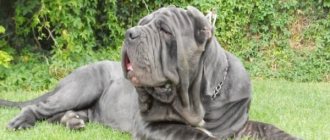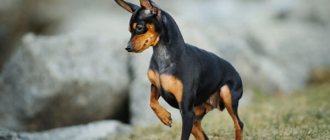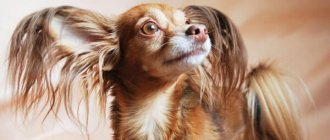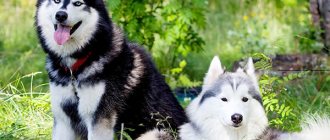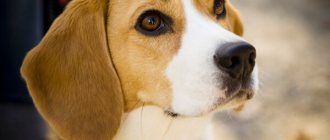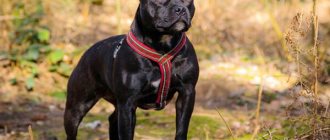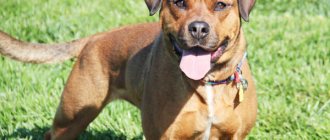Spaniels are one of the most popular hunting dogs.
Among their varieties, the most famous are Cocker Spaniels, Russian Spaniels, King Charles Spaniels and Cavalier Charles King Spaniels, but besides them there are less famous representatives that also deserve attention, including the Breton Espanole.
Breton Spaniels were developed in France and are still the most common hunting dog there.
Being the smallest among the cops, the Bretons are not inferior to them in terms of working qualities, which, combined with intelligence, complaisance and a friendly disposition, determined their popularity.
In this article you will find a comprehensive description of this wonderful breed, and also learn about the features of its maintenance.
Origin story
The Breton Spaniel or, as it is also called, the French Spaniel is a breed of dog native to the province of Brittany , France.
The first drawings depicting similar animals date back to the 18th century, but the first official mention dates back to 1850, when the priest of the French suburb of Davis described a hunting pointer with a naturally docked tail, used for gun hunting.
Representatives of this breed acquired their modern appearance only at the beginning of the 20th century. as a result of the selection of the best individuals and breeding work, during which, according to some sources, springer spaniels and English setters were used.
At the beginning of the 20th century. A Parisian all-breed exhibition was held, where the breed appeared before the canine community under its current name. These dogs quickly gained popularity due to their temperament, intelligence, gentle disposition and charming appearance.
NOTE!
The first breed standard was drawn up in 1907; Breton Spaniards received FCI recognition in 1954.
History of the Russian Hunting Spaniel breed
Russian hunting spaniel
The appearance of spaniels in Russia is associated with the name of Nikolai Nikolaevich Romanov, the uncle of the last Russian Tsar. Being a keen breeder and leader of several hunting communities, he often brought various breeds of dogs from trips abroad. In particular, a cocker spaniel named Dash, exhibited at the 1885 exhibition, also belonged to the Grand Duke, who purchased the dog from an elite English kennel. Subsequently, it was this male who became the father of several generations of puppies, which were sold to Russian nobles.
With the easy encouragement of N.N. Romanov, the interest of domestic dog breeders in spaniels quickly acquired a practical orientation. Although with some delay, breeders still discovered excellent hunters in dogs, capable of working with any type of bird. In addition, imported cockers and springers performed well in pheasant hunting, which was especially respected by members of the imperial family, so that breeding soon became a profitable and prestigious business.
At first, breeding specimens were imported from England, after which they were haphazardly bred with spaniels from royal and princely nurseries. The offspring obtained as a result of such experiments, although they had a spaniel appearance, bore little resemblance to their foreign parents. Actually, these were the first Russian hunting spaniels - non-standardized, without pedigrees, but with the same working characteristics as modern representatives of the breed.
By the beginning of the 20th century, spaniels born in Russia were exhibited at breeding exhibitions separately from their English relatives. During the same period, the stratification of the unofficial breed into Moscow and St. Petersburg types became especially noticeable. Representatives of each of the “castes” differed both in appearance and in their style of work, which became the reason for further experiments in crossing both varieties.
In the 30s, the Leningrad section of spaniels took up the task of improving the breed, using domestic dogs and imported males for mating: the half-springer Alba von Blummenthal and the cocker spaniel Caesar von der Schmich. Unfortunately, the developments of those years were destroyed by the Great Patriotic War and the blockade, so after the victory the number of animals was restored almost from scratch. The task was also seriously complicated by the heterogeneity of the domestic livestock, which was full of mestizos.
In 1951, Soviet specialists finally fixed the phenotype of the breed and issued the first appearance standard for its representatives. Since 1972, an official ban on mating between Russian hunting and other varieties of spaniels was introduced, which was the last step towards the independence of animals.
Already in the 60s, owning a breed became fashionable among domestic hunters. Compact and extremely prey, such dogs did not create problems with transportation and easily took root in city apartments. And although in the 90s the number of Russian hunting spaniels was reduced to a critical minimum, they were not allowed to completely disappear, taking a number of measures to revive and increase the number of purebred individuals.
Description and standard
Breton Spaniards are the smallest of the cops, with a strong, stocky build and a harmonious silhouette with smooth lines. These are ideal, passionate and hardy hunting dogs, capable of well-orientated terrain, with good search abilities and the ability to work in any terrain.
Representatives of this breed are characterized by an unusual walking style - it seems that at a constant speed the dog jumps like a spring, while its body forms a solid ball.
FCI standard:
- the length of the body is equal to the height of the dog at the withers;
- tucked stomach;
- the back is short and straight, the loin is wide and short, the croup is straight and strong;
- the chest is wide;
- the neck is moderately long, muscular, cone-shaped;
- the skull is slightly rounded at the front and side;
- the head is wide, the transition from the forehead to the elongated muzzle is smooth;
- the ears are short, hanging and mobile, triangular in shape, set high, the upper part is covered with wavy hair;
- the eyes are oval, the iris is pigmented to match the coat;
- the nose is wide, the lobe is colored like the eyelids;
- scissor bite;
- limbs are slender, with developed muscles, set vertically and parallel, the front ones are shorter than the rear ones;
- the tail is straight, docked length is 3-6 cm, if it is of natural length, then no more than 10 cm, the absence of a tail from birth is not considered a defect.
The coat is smooth or slightly wavy, shorter in front than in back, with no undercoat.
Breed standard Russian hunting spaniel
The Russian spaniel is a long-legged “pathfinder” of an elongated format, with a strong, muscular body. It is slightly taller than its relative, the English Cocker, but much lower and smaller than the Springer. Since the breed was bred exclusively for work, the emphasis was placed on its searching qualities and endurance, and not on its appearance. And yet the long-eared shaggy animals do not look too primitive. Of course, Russian hunting spaniels are infinitely far from the glamorous American cockers, but they are not without light charm and discreet grace.
The breed standard stipulates a height of 38-44 cm for males and 36-42 cm for females. Russian hunting spaniels weigh from 13 to 16 kilograms.
Head
Moderately long, dry, with a wide skull and elongated muzzle. The eyebrows are barely protruding, the occipital protuberance is smoothed. The dog's muzzle is well filled and, when viewed in profile, has a slightly blunt shape. Lips are thin and taut.
Bite and teeth
A purebred individual's teeth should be white and in full quantity. The standard bite shape is scissor.
Nose
Massive, with well-opened nostrils, colored to match the main color (from chocolate to black).
Eyes
The eyes of Russian hunting spaniels are large, straight set, in the shape of a regular oval. Desirable shades of the iris are brown and dark brown. Light brown eyes are also acceptable, but only for individuals with brown and brown-white coat colors.
Ears
The breed has classic spaniel ears - long, lobe-shaped, hanging freely along the cheekbones. The base of the ear is located at eye level, sometimes a little higher. In an extended position, the tip of the ear reaches the tip of the nose.
Neck
The Russian Spaniel's neck should be dry, of moderate length, with harmoniously developed muscles.
Frame
The dog's body is strong and elongated. The topline is slightly sloping, with a wide back and a short loin, merging into a massive, slightly sloping croup. The chest is developed, of good depth, but not excessively broad. The bottom line is noticeably tightened.
Limbs
The dry, bony legs of the Russian Hunting Spaniel are set almost parallel to each other. The shoulder blades are inclined, located at an angle of 100°, the elbows are directed back. The forearms are smooth, turning into strong, massive pasterns. The hind legs are characterized by a wider stance and pronounced articulation angles. The lower legs are visually long with voluminous, straight metatarsals and wide hocks. The breed's paws are round and arched. The Russian hunting spaniel moves at a light gallop, followed by a trot when the animal runs over rough terrain.
Tail
The straight, flexible tail of the Russian Spaniel continues the line of his croup. Particularly massive at the base and “weighted” by the dewlap, it is held at the level of the back, but in an excited animal it rises higher. For working dogs, ½ of the tail is docked to avoid damage during the pursuit of game. Natural length is also possible, especially if the Russian Spaniel does not hunt.
Wool
The dog's coat is long, straight or with a slight wave. The hair is shiny, silky, well covering the animal's body. On the head and along the front of all four legs, the coat is short and close-lying. On the back, rump, upper neck and sides the hair is longer. The bottom of the neck, chest, back of the limbs and belly are areas with dewlaps and abundant hair.
Color
Russian spaniels are characterized by three types of colors: solid, two- and three-color. Solid coated dogs are black, brown, red (including all shades of fawn) individuals that may have minor white markings on the chest and throat. Two-color spaniels combine the same colors, but “diluted” with clearly defined white spots. Tricolor representatives of the breed are brown-white and black-and-white animals with tan. The presence of speckled/roan colors is also acceptable if they do not contrast with the main tone of the coat.
Disqualifying faults
- Unreasonable aggressive/cowardly behavior.
- Presence of extra incisor teeth.
- Missing canine, molar (M3 does not count), incisor or P4 in the maxilla.
- Broken incisors or lack of two P4s in the lower jaw.
- Disagreement.
- Any suits not specified by the standard.
- Depigmented lips and nose.
- Cryptorchidism.
- Short tail from birth.
- Various bite defects, including jaw misalignment.
Character traits
Breton Spaniards are lively, sociable and energetic dogs with a balanced and friendly character and appreciate an affectionate and caring attitude.
Representatives of this breed treat everyone well, they are happy to see even people they don’t know, so using them as watchmen and security guards will not work.
Bretons become very attached to their owner and do not tolerate loneliness well. Therefore, if you need to leave your pet alone, before doing so, you need to provide him with a long and active walk, so that in the absence of his owners, the dog sleeps, restoring his strength.
These dogs are smart and amenable to training; the main thing is not to scold your pet during the training process, much less physically punish it. This will only lead to the pet growing up scared and insecure.
Expert opinion
Kozhevin Semyon Kirillovich
Expert dog handler.
Bretons are friendly and have an affectionate disposition, but do not think that they lack firmness and inner strength. Representatives of this breed can be quite stubborn and assertive, which is why it is important to raise and socialize them correctly. These dogs are by nature wonderful companions, which explains their desire to always be close not only to their owner, but also to people in general. When getting such a pet, you should remember that these are true hunters, so it is advisable to use them for their intended purpose, taking them with you hunting, or at least provide them with regular and active walks and physical activity.
Character of the Russian Spaniel
Persistent and tireless in work, in a home environment the Russian hunting spaniel is transformed, transforming into a pleasant, good-natured pet. Moreover, with this shaggy psychotherapist you can always whisper about secrets or spend the evening watching the “Hunter and Fisherman” channel. In everyday life, a Russian spaniel doesn’t care what to do, as long as it doesn’t lose contact with its owner.
Even into adulthood, representatives of the breed retain puppy playfulness and interest in entertainment. This helps them join children's groups, in which long-eared gamers feel like fish in water. By the way, dogs do not conflict with babies, generously forgiving her for minor harms like pulling her tail and ears.
The Russian Hunting Spaniel's favorite games are fetching all kinds of balls and, of course, searching for objects, so don't be lazy to devote at least 10-20 minutes a day to your pet's hobbies. However, you don’t have to do this, but then you need to calmly accept the fact that the dog will have fun on its own. Typically, Russian hunting spaniels compensate for the lack of play with destructive behavior, so just to be on the safe side, hide your Nikes and Adidas shoes away. Spaniels love to chew leather products and anything that even slightly resembles it.
The breed has a very developed intuitive sense: its representatives easily detect changes in the owner’s mood, understand any requirement at a glance, and masterfully differentiate all people into good and suspicious people. If a spaniel growls with enviable consistency at one of your old friends, there is reason to think about it.
Advantages and disadvantages
Among the main advantages of representatives of this breed are:
- communication skills;
- lack of aggression;
- friendliness;
- devotion;
- endurance;
- intelligence and intelligence;
- love for children;
- ability to get along with other pets;
- lack of tendency to dominate.
Disadvantages of Breton epagnoles:
- inability to be used as watchmen and security guards;
- stubbornness;
- the need for proper education and socialization.
IMPORTANT!
In addition, representatives of this breed need long walks and physical activity, ideally regular participation in hunting.
Photos of color variations
The official breed standard allows several coat color options for Breton Spaniels:
- white-red;
- black and white:
- white-brown;
- piebald;
- tricolor.
In the area of the muzzle, on the chest and limbs, the presence of specks or gray hair and the presence of a third color in the form of fiery spots are acceptable.
Relationship with other pets and children
Representatives of this breed get along well with children, play with them and patiently endure their pranks. At the same time, if the child is under school age, it is better not to leave him alone with the pet.
Breton Spaniards love to be the center of attention, but they do not tend to dominate and do not pretend to be leaders. Therefore, representatives of this breed, subject to proper and early socialization, get along without problems with other animals, including cats and birds.
English cocker
The breed originated with Norfolks, ancient dogs with hunting abilities. It was from them that two different branches of Spaniels came - heavy Springers and medium-sized (up to 41 cm at the withers) Cockers. They hunt birds.
Most likely, the standard appearance of the Spaniel, which everyone knows, refers precisely to the English Cockers: these are small stocky dogs with a wide loin, a long body, a wedge-shaped muzzle, large drooping ears, and wavy hair. Animals have a good sense of smell thanks to their large sensitive nose and good eyesight. The breed is subject to strict standards. Which you can find in a detailed article about the English Cocker.
A hunting working dog that has migrated to a person’s apartment quickly gains weight due to a lazy lifestyle. Although initially Spaniels are real athletes: fast, agile, strong, fit. Without proper care and education, a pet becomes lazy.
Dogs are family men, they love people, they treat children well, but they are wary of strangers and rarely get along with cats and small animals. Pets are sensitive to the mood of the owner and the atmosphere in the house. They need a loving family with an active lifestyle. The average cost is 10,000-20,000 rubles.
How to properly care?
Bretons are unpretentious dogs and do not require labor-intensive care. At the same time, it is important to carry out all hygiene procedures regularly, having accustomed your pet to them from early childhood.
Wool and bathing
Comb the coat 2-3 times a week, paying special attention to the fringes, since this is where tangles most often appear and thorns and grass get tangled in them.
The dog should be bathed as needed, but not more than once a month.
Ears
Inspect and clean the ears weekly from wax and dust with a cotton pad soaked in a special product or peroxide.
Claws
With regular active walks, the Breton's claws are ground down to the required length on their own. If this does not happen, they must be shortened with a guillotine nail cutter every 3-4 weeks - this prevents the so-called “unraveling” of the paws.
Eyes
Every morning, wipe with a lint-free cloth soaked in tea leaves or chamomile infusion.
Teeth
To prevent the appearance of plaque and tartar, your pet’s teeth should be brushed weekly using a special paste and brush for dogs. You should also give your Breton dog treats and chewing toys that help mechanically clean the teeth.
Life expectancy and major diseases
With proper care and proper maintenance conditions, Breton epagnoles live on average 14-15 years, remaining functional for quite a long time (up to 10-12 years).
In general, representatives of this breed have fairly good health, but they still have a tendency to develop diseases such as:
- dysplasia of the hip and elbow joints;
- epilepsy;
- hypothyroidism
- breast cancer in young whelping bitches;
- discoid lupus erythematosus;
- progressive retinal atrophy;
- ear infections.
In addition, Breton epagnoles are prone to infection with parasitic pathologies.
Health and diseases of Russian hunting spaniels
The breed does not suffer from serious genetic diseases, but, like any other dog, the Russian Hunting Spaniel is capable of contracting an infection. For example, animals that often have to dive into ponds and swamps for killed game are at risk of contracting leptospirosis, an acute infection accompanied by damage to the capillaries, liver and kidneys. Quite often, dogs suffer from fungal diseases such as dermatomycosis, as well as parasitic infections such as toxoplasmosis and helminthiasis.
The long, floppy ears of Russian Spaniels can also cause a lot of problems, since such “designs” are ideal for the development of otitis media. Individuals who bathe frequently are especially susceptible to the disease: getting water inside the ear canal is an almost guaranteed inflammation. In addition, the breed has a pathological tendency to be overweight, aggravated by food allergies, which requires the owner to take a careful approach to selecting food and painstakingly create a menu.
Nutritional Features
Most breeders prefer to feed their dogs commercial dry food because it is convenient and does not require much time to prepare the food. In addition, dry food contains all the necessary minerals and vitamins, and the special composition with which the granules are processed helps clean teeth.
It is important to choose only high-quality food that does not contain chemical flavors, flavor enhancers and dyes. The most suitable diets for representatives of this breed are made by the brands Acana, Orijen, Happy Dog, Royal Canin, Arden Grange, 1st Choice, Artemis, Almo Nature, Brit Premium, Canidae.
Natural feeding gives the owner the opportunity to independently choose the freshest and highest quality products for the dog, and the fact that all the nutrients in them are of natural origin improves their absorption by the pet’s body. A significant disadvantage of this diet is that it requires a lot of time to prepare food for the dog every day.
If you decide to feed your pet natural products, you should take into account that the diet must be balanced, and the diet must include:
- sea fish (cod, pollock, pollock, flounder, mullet, trout, hake);
- lean meat (beef, veal, turkey, chicken);
- porridge (rice, buckwheat, oatmeal);
- offal (heart, liver, lung, tripe);
- seasonal vegetables and fruits (carrots, pumpkin, bell peppers, zucchini, apples, bananas, pears);
- boiled eggs (no more than 2 per week);
- low-fat fermented milk products (cottage cheese, kefir, natural yogurt).
You should also give your pet a small amount of vegetable oils, which have a beneficial effect on the quality of the coat, and cartilage and tendons, which are beneficial for bones and joints.
The list of prohibited products includes:
- legumes;
- fat meat;
- river fish;
- potato;
- cabbage;
- smoked meats and sausages;
- fried and salty foods;
- citrus;
- tubular bones.
NOTE!
With a natural type of feeding, the dog must be given an additional complex of vitamins and minerals.
Education, training, coaching
Training the Russian Hunting Spaniel is easy. Smart and efficient, these shaggy “bundles of energy” quickly understand what is required of them and are almost not prone to whims. In addition, spaniels have an excellent memory for words, which is already quite valuable. However, you should not overload your dog with various training courses. The Russian Hunting Spaniel is primarily a hunter and tracker, for which five basic commands are enough for full-fledged work.
Raising a baby begins after moving to a permanent owner, and the first thing the baby needs to figure out is identifying the identity of the owner. In the future, it is this person who will be able to control the dog’s behavior both during hunting and in everyday life, therefore, in the first month after the puppy appears in the house, its basic needs should be satisfied by only one family member.
Accustoming to a nickname begins from the first days after moving from the nursery. But don’t overdo it: the animal’s name should not become synonymous with the call “Come to me!” The next stage is mastering the commands: “Place!” (worked out first), “You can’t!” and “Take it!” This is no longer just behavior management, but also preparation for subsequent training. Keep in mind: the life of a Russian hunting spaniel that has not learned basic commands will be short-lived.
A necessary skill for hunting individuals is to fulfill the “Give it!” requirement. Dogs master this skill easily, since the passion for fetching objects is in the breed’s blood. But it’s one thing to fetch a ball and quite another to drag a shot grouse, so stock up on duck wings and tufts of feathers in advance to throw them to the dog instead of toys.
A more significant alternative to wings is a bird carcass frozen from the last hunting season. However, according to experienced dog lovers, the method does not always work as it should. In particular, having trained on a frozen bird, the Russian spaniel loses interest in warm prey. In such cases, it is recommended to put the patient on a strict diet (1-2 days). A fairly hungry spaniel quickly forgets about the feeling of disgust and works with fresh game as it should.
Picking up a shot bird from the water and its subsequent removal is handled in the same way as a regular offering of a bird. The only difference is that this time the wing or stuffed animal will be thrown into the water. It is better to start training in the summer, when the water is warm, and continue until the fall, so that the dog hardens. In general, you can practice serving with a Russian hunting spaniel as early as 3 months. But with full training you will have to wait until the pet has learned the basic obedience commands. This usually happens by 4-5 months.
Among professional hunters, there are often cases of purchasing adult Russian spaniels with subsequent training. This is done in order to “skip over” the childhood and teenage periods, when a lot of time, effort and financial resources are spent on raising and socializing a puppy. Of course, it is much more difficult to train and train grown individuals, but this is a feasible task for a specialist who has experience communicating with the breed. By the way, it is quite possible to raise a champion from an adult dog who will award the owner with working diplomas and certificates of honor.
How to choose a puppy?
You should purchase a puppy no earlier than he is 8-12 weeks old and only from professional breeders in pedigree nurseries, where you can look at the parents of the future pet, learn about their health and character, and also get advice from the breeder regarding the care and feeding of the puppy.
IMPORTANT!
Before purchasing a puppy, you must carefully examine it and make sure that it meets the breed standard and that there are no pathologies or developmental abnormalities. It should not emit an unpleasant ammonia odor, the puppy should not have a rash, irritation, increased lacrimation, lameness, a bloated abdomen and other symptoms of disease.
You should choose the most active and curious puppy from the litter who does not show aggression or cowardice and easily makes contact with strangers.
Price range
Prices for Breton Epagnole puppies in Russia vary greatly. So, you can buy a puppy from private breeders for about 15 thousand rubles, if the sale is at a lower price, this may indicate that the baby does not have documents confirming the origin, or his illness.
In specialized nurseries, representatives of the breed that fully comply with the standard, born from titled parents and with exhibition prospects cost an average of 35-50 thousand rubles.
Nurseries in Russia and CIS
The most famous Breton Espanole nurseries in Russia and the CIS:
- From Grin Valley, Russia, Simferopol (in Crimea);
- “Free Wind”, Ukraine, Kyiv;
- “Call of the Fields”, Russia, Moscow;
- Darkadivka, Ukraine, Kyiv;
- De La Casa De Cazador, Ukraine, Odessa;
- Don Field Spirit, Ukraine, Zaporozhye;
- “From the Free Wind”, Ukraine, Kyiv.
There are also many national breed clubs (NCB) of Breton Espanoli.

